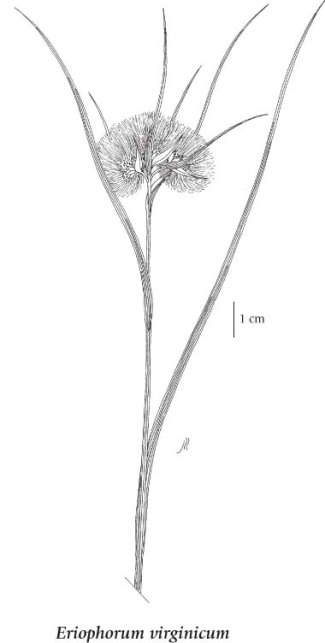tawny cotton-grass (tawny cottongrass)
Cyperaceae (Sedge family)
Introduction to Vascular Plants
Introduction click to expand contents
Tawny cotton-grass (a.k.a. tawny bog cotton) is an easily recognized rhizomatous (clonal) species of cotton-grass. Like other species of cotton-grass, it is mostly restricted to peatlands where it can be a prominent component. Eriophorum species in general are boreal in distribution and are mostly circumpolar. The exception is tawny cotton-grass, which is found only in eastern North America from Ontario, Quebec, and Labardor south to the Carolinas. It has been introduced in British Columbia in the Fraser delta, where it can be seen in many delta bogs, including the Lulu Island Bog, Burns Bog, and the Langley Bog.
This is a late-flowering species of cotton-grass. As perianth bristles expand in this species they become tawny and brownish. It is anatomically different from other species of cotton-grass.
View a video about identifying tawny cotton-grass in the field, with Tony Reznicek.
|
Species Information click to expand contents
General:
Perennial herb from rhizomes; stems solitary or few together, stiff, erect, up to 100 cm tall.
Leaves:
Sheaths brownish to purplish, persistent; blades 2-4 mm wide, flat, except at the tips.
Flowers:
Spikes several, terminal, in crowded clusters, the stalks short and nearly equal; anthers 1-1.5 mm long; involucral bracts 2 (3), unequal, leaflike, the longest greatly surpassing the inflorescence.
Fruits:
Scales coppery or brown, blunt or pointed, the midribs prominently 3- to 5-nerved; perianth bristles numerous, tawny or coppery, many times longer than the achenes; achenes 3-3.5 mm long, a third as wide.
Illustration click to expand contents

If more than one illustration is available for a species (e.g., separate illustrations were provided for two subspecies) then links to the separate images will be provided below. Note that individual subspecies or varietal illustrations are not always available.
Illustration Source: The Illustrated Flora of British Columbia
USDA Species Characteristics click to expand contents
Flower Colour:
Green
Blooming Period:
Indeterminate
Fruit/Seed characteristics:
Colour: Black
Present from Summer to Fall
Source: The USDA
Habitat and Range click to expand contents
Status Information click to expand contents
Taxonomic Keys click to expand contents
Key to Eriophorum
1. Spikes 2 or more, subtended by one or more leaflike involucral bracts.
2. Leaves narrow, elongate, folded or triangular in cross-section; involucral bracts solitary, shorter than the inflorescence...........................................E. gracile
3. Spikes crowded, the scales with several conspicuous ribs; perianth bristles orange-brown or coppery...........................................E. virginicum
4. Midribs of scales extending to the tips, sheaths green...............E. viridcarinatum
5. Plants rhizomatous or stoloniferous, usually with solitary stems...............E. scheuchzeri
6. Scales with broad, pale margins, the basal ones reflexed................E. vaginatum
7. Perianth bristles pure white with silky sheen; plants 6-25 cm tall..............E. callitrix Source: Illustrated Flora of British Columbia |
